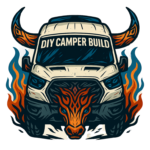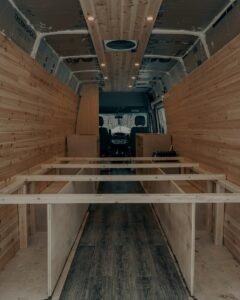Let’s face it, pre-built van cabinets can be a budget-buster, and bulky plastic bins feel more like a dorm room than a dream adventure machine.
There’s a better way! DIY van cabinets offer the perfect blend of customization, functionality, and affordability. You can create a storage system that perfectly fits your van’s unique layout and your adventuring needs, all without breaking the bank.
Picture hidden compartments for valuables, slide-out drawers for easy access, and overhead cabinets that maximize your vertical space. DIY van cabinets allow you to bring this dream to life, creating a personalized living space that makes every van life adventure more comfortable and enjoyable.
This guide will equip you with everything you need to build your own budget-friendly van cabinets. We’ll walk you through the planning process, material selection, step-by-step construction tips, and clever design hacks to maximize your space.
You’re going to need the following materials to build cabinets for your camper van: 5/8″ plywood, wood screws, hinges (if you opt for a door), spackling (to fill any gaps and make it look seamless) and paint to make it look nice. Plywood is the lightest material you could possibly use for cabinets and considering that you might have a lot, we really want to make them as efficient as possible. So, let’s get to work and break this down into manageable steps.
Building the body of the cabinets
We’ve tackled the excitement, now let’s get down to the fun part: building the body of your van cabinets! The good news is, constructing the basic frame is a relatively straightforward process. Here’s where your DIY spirit shines!
However, unlike a standard rectangular cabinet, we need to account for the unique curves of your van. This usually means introducing an angle at the sides of the frame to ensure the cabinet sits flush and maintains a straight vertical line.
For instance, if you’re working with a popular choice like the Ford Transit, the natural curve of the van wall dictates a 1-inch difference between the bottom and top depth of your cabinet frame. This angle will create a plumb (perfectly vertical) cabinet despite the van’s slight inward curve.
Here’s how to achieve this angled cut:
- Measure & Mark: First, determine the desired height and depth of your cabinet. Using a level, mark a perfectly straight line on a piece of plywood for the cabinet back. Now, at the bottom of that line, measure and mark out 1 inch less than your desired depth (for a Ford Transit). This will be your cutting guide for the angled side.
- Cutting the Angle: Transfer this marked line to your chosen wood material (plywood, MDF, etc.). Using a circular saw or jigsaw, carefully cut along the angled line, creating the angled side piece.
- Mirror the Angle: Repeat steps 1 and 2 to create the matching angled side piece for the opposite side of the cabinet.
Pro Tip: Double-check your measurements and cuts before assembling the frame. You can use a carpenter’s square to ensure your angled sides are perfectly aligned at 90 degrees with the cabinet back.
Installing a cabinet door
With the cabinet frame constructed, it’s time to focus on the all-important door! Here’s where your meticulous planning and precise cuts pay off.
For optimal aesthetics and functionality, we want the door to sit flush with the cabinet frame on all sides. To achieve this, the hinges will be installed at the top of the cabinet. This placement allows for slight adjustments during the hanging process.
Finding Perfect Placement:
- Test Fitting: Carefully position the cabinet door onto the frame. Use shims (thin wedges of wood) as needed to ensure the door is plumb (perfectly vertical) and has an even gap around the entire frame. A level will be your best friend here!
- Marking Hinge Positions: With the door perfectly positioned and shimmed, use a pencil to mark the exact location of the hinge mounting plates on both the cabinet frame and the door itself. Double-check these markings for accuracy before drilling any pilot holes.
Important Note:
We’ll hold off on actually installing the hinges and attaching the door just yet. Why? Because the final touches, like sanding and painting, are much easier to achieve with the door removed. Plus, waiting allows for any minor adjustments that might be needed after the finishing touches are complete.
Spring into Security (Later):
For an extra layer of security and a satisfying “snick” when closing the door, spring magnets can be installed. However, this is best done at the very end, once your masterpiece is sanded, painted, and ready to shine.
For now, focus on achieving that perfect fit and alignment. The reward of a flawlessly hung cabinet door awaits!
Finishing, sanding and painting your cabinets
Now that your cabinet frame is built and the door is perfectly aligned, it’s time to focus on the details that transform a DIY project into a work of art. This stage involves filling minor imperfections, achieving a smooth finish, and expressing your personal style through paint.
Smoothing the Way with Spackle:
While wood filler might be the first product that comes to mind, here’s a budget-friendly secret: spackle is a fantastic alternative for filling small gaps and screw holes in your van cabinets. Not only is it more affordable, but it’s also considerably easier to apply and sand.
- Apply & Smooth: Using a putty knife, spread a thin layer of spackle over any gaps or imperfections on the cabinet frame and door. Focus on creating a smooth, even surface.
- Let it Dry: Allow the spackle to dry completely according to the manufacturer’s instructions. This usually takes just a few hours.
Sanding for Perfection (Literally):
The beauty of DIY is that you get to personalize every step. When it comes to sanding, the level of smoothness is entirely up to you!
- For a Flawless Feel: If you crave a super smooth, furniture-grade finish, opt for finer sandpaper grits (around 220 or higher) and take your time with a sanding block. This will create a luxuriously smooth surface, perfect for a modern aesthetic.
- A Touch of Rustic Charm: For a more rustic look, you can use a slightly coarser sandpaper grit (around 120-150) and focus on achieving a smooth overall feel without eliminating all the natural wood grain texture.
Pro Tip: Rounding the edges with sandpaper adds a touch of finesse and helps prevent snags on clothing or belongings.
Painting Your Masterpiece:
Now comes the fun part: expressing your personality through paint! While the choice of color is entirely yours, starting with a coat of white primer is highly recommended.
- Primer Power: Primer creates a uniform base coat that helps the paint adhere better and provides a more vibrant final finish.
Once the primer is dry, unleash your creativity! Choose a paint color that complements your van’s interior and reflects your personal style.
Remember: Multiple thin coats are always better than one thick coat. This ensures a smooth, even finish and prevents drips or runs.
With a little spackle, some thoughtful sanding, and a splash of paint, your DIY van cabinets are well on their way to becoming a stunning focal point in your mobile home!
Installing your cabinets in the van
Congratulations! Your van cabinets are looking fantastic – meticulously crafted, perfectly aligned, and sporting a fresh coat of paint. Now it’s time to transform them from beautiful built-ins into functional storage solutions within your van.
If you’ve followed our guide on framing your van walls [link to van framing guide], this step should be a breeze! The strategically placed 1×6 studs provide the perfect framework for mounting your cabinets securely.
Mounting Magic:
- Double-Check Placement: Before drilling any holes, ensure your cabinets are positioned precisely where you want them. Use a level to confirm everything is plumb and square.
- Mark It Up: With the cabinets perfectly positioned, use a pencil to mark the locations where the screws will go through the cabinet back and into the wall studs. Having a helper hold the cabinet in place while you mark can be extremely helpful.
- Pilot Holes are Your Friend: Drill pilot holes at each marked location. This prevents the wood from splitting when you screw in the cabinet mounts.
- Screw it On! Using wood screws of appropriate length (depending on the thickness of your cabinets and wall studs), securely fasten the cabinets to the wall studs. Be sure to tighten the screws firmly, but avoid over-tightening.
Strength in Numbers:
With ample surface area on both the cabinets and the wall studs, you should have multiple points to securely mount each cabinet. This ensures a strong and stable hold for all your belongings.
Pro Tip: For particularly heavy cabinets, or if you plan on storing very heavy items, consider adding L-brackets for additional support. These can be screwed onto the back corners of the cabinet and into the wall studs, providing extra reinforcement.
By following these steps, you’ll transform your handcrafted cabinets from workshop creations into permanent fixtures within your van, ready to store your gear and keep your vanlife adventure organized and enjoyable.
Summary
There you have it! You’ve conquered the exciting challenge of building your very own van cabinets. From crafting the frame to achieving a flawless finish, you’ve transformed raw materials into a functional and stylish centerpiece for your vanlife adventure. Not only did you save money compared to pre-built options, but you’ve also created something truly unique – a storage solution perfectly tailored to your van’s layout and personal needs. The sense of accomplishment and the joy of using your handcrafted cabinets will undoubtedly add to the satisfaction of your vanlife experience.
Your Vanlife Journey Continues!
This is just the beginning!
- Join us next week (Week 10) for a deep dive into the world of electrical and plumbing systems for your van. We’ll equip you with the knowledge and essential steps to bring your mobile home to life!
- Don’t Miss a Beat! Need a refresher on a previous step? Head over to last week’s post (Week 8) where we tackled the topic of building comfortable and functional van bench seats.
Feeling inspired? Share your DIY van conversion journey and connect with fellow vanlifers in our thriving online community, the DIY Camper Build family! Let’s see your amazing creations and share vanlife wisdom together!





